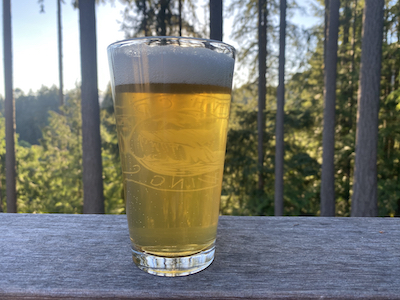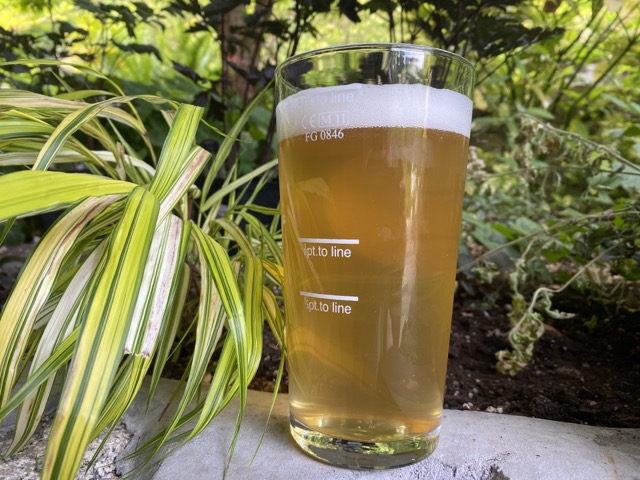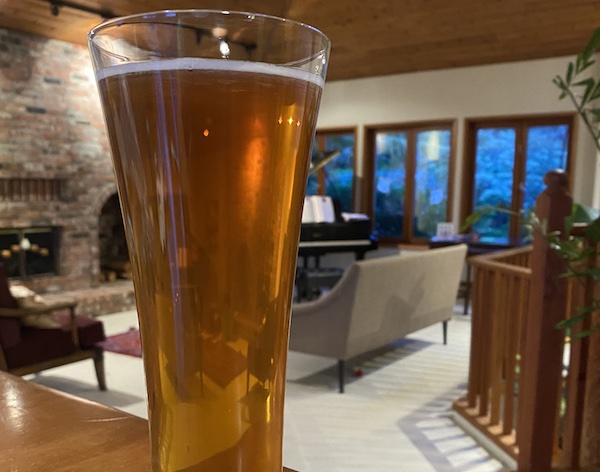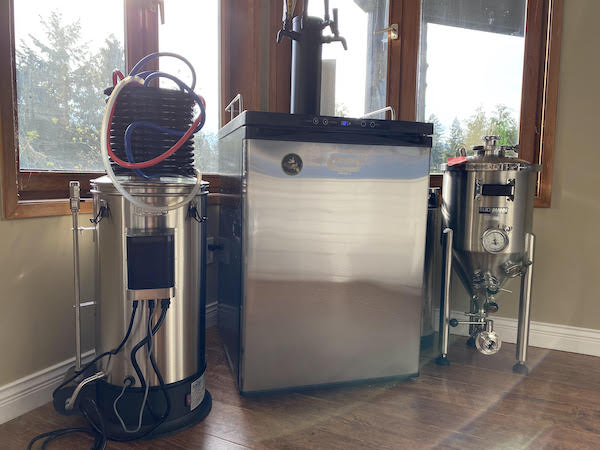Tag Homebrewing
Throwback Dry Hopped Cream Ale
Recipe: American Cream Ale (BJCP 6A). Malts: Canadian Pilsner, Canadian 2-row, flaked corn, carapils. Hops: Northern Brewer (1oz) and Cascade (2oz). Yeast: LalBrew Novalager. An easy drinking dry-hopped cream ale homebrew recipe. BJCP: 01C. Cream Ale.
 Continuing on my lager quest I saw it fitting to brew a classic American Cream Ale, BJCP category 6A. This recipe is as standard as an American Cream Ale can get, except for the 1 oz charge of cryo-Cascade at the end. Despite the dry hop, this beer has all the lawnmower feels I love about American beer: it is plebeian, boring, and crushable. I would recommend you try this beer if you too appreciate thirst quenching lagers.
Continuing on my lager quest I saw it fitting to brew a classic American Cream Ale, BJCP category 6A. This recipe is as standard as an American Cream Ale can get, except for the 1 oz charge of cryo-Cascade at the end. Despite the dry hop, this beer has all the lawnmower feels I love about American beer: it is plebeian, boring, and crushable. I would recommend you try this beer if you too appreciate thirst quenching lagers.
Ale Tales - Bohemian Pils
Bohemian Pilsner. Malts: German Pilsner, Carapils. Hops: Saaz (1.25oz), Saaz (1.75oz), Saaz (1oz), Saaz (1oz). Yeast: SafLager W-34/70.
 I decided to start my pilsner journey with a known recipe this time from Brewing Classic Styles. Putting my own preferences aside this recipe is solid ground to build upon (obviously). I adjusted the malt and hops to better fit my brewery utilizations, specifically I toned down the hop additions and decreased the base malt. The beer turned out fantastic and it won’t last long. Unfortunately I’ll need to wait another 4-6 months before I can brew pilsners again!
I decided to start my pilsner journey with a known recipe this time from Brewing Classic Styles. Putting my own preferences aside this recipe is solid ground to build upon (obviously). I adjusted the malt and hops to better fit my brewery utilizations, specifically I toned down the hop additions and decreased the base malt. The beer turned out fantastic and it won’t last long. Unfortunately I’ll need to wait another 4-6 months before I can brew pilsners again!
Ale Tales - American Pale Ale
American Pale Ale. Malts: Canadian 2-row, Canadian Pilsner, Munich. Hops: Columbus (0.25oz), Vic Secret (1oz), Mosaic (1oz), Vic Secret (1oz), Mosaic (1oz). Yeast: SafAle US-05.
This is the second beer on my journey to finding a house American Pale Ale. What I’m looking for in an APA is a beer that first pleases my eyes and nose; for me that means a clear golden to copper colored beer, nice tight white head, and mostly floral and tropical fruit notes on the nose. Though I like tropical fruit, I explicitly steer clear of hazy or “juicy” style beers. The second requirement for an APA is that I can drink four pints and wake up relatively coherent. As far as taste goes, I’m looking for a firm bitterness but mellow floral, piney, and stone fruit notes throughout.
Ale Tales - Festbier
Festbier. Malts: German Pilsner, Munich, Carapils. Hops: Hallertau (0.75oz), Hallertau (1oz). Yeast: SafLager W-34/70.
 All I want to drink are lagers, but good german style lagers are hard to come by in Vancouver. So, taking matters into my own hands I’ve started a journey to create a festbier. This recipe is beginning life as something between a marzen and munich lager. The intention is to let it drift over time, most likely however it will end life pretty close to a modern festbier: golden in color, 5.5% alcohol, and a moderately bright hop flavor. I’m aiming for something highly drinkable, low in alcohol, and easy on the hops.
All I want to drink are lagers, but good german style lagers are hard to come by in Vancouver. So, taking matters into my own hands I’ve started a journey to create a festbier. This recipe is beginning life as something between a marzen and munich lager. The intention is to let it drift over time, most likely however it will end life pretty close to a modern festbier: golden in color, 5.5% alcohol, and a moderately bright hop flavor. I’m aiming for something highly drinkable, low in alcohol, and easy on the hops.
Brew Day Standard Operating Procedures
I recently began utilizing standard operating procedures for my brew day: step-by-step instructions of everything I need to do on brew day from setting up and filling my kettle to cleaning it and putting it away.
I recently began utilizing standard operating procedures for my brew day: step-by-step instructions of everything I need to do on brew day from setting up and filling my kettle to cleaning it and putting it away. I recently started this practice after forgetting to treat my sparge water. While not a critical step to the brew day, it nonetheless highlighted that left to own devices I will inevitably forget steps. Apart from fixing my forgetfulness, having a written set of instructions has had two unexpected but welcome side effects: first, by having the mundane written down my mind is free to focus or wander as it pleases and second, it has sped up my brew day considerably.
Grainfather - Lessons Learned
This post documents a couple problems I've had with the Grainfather. I also document my attempts to overcome those problems.
This post documents a couple problems I’ve had with the Grainfather. I also document my attempts to overcome those problems. To be clear, the Grainfather is a slick homebrewing appliance that automates away a lot of the mundane work of brewing. I absolutely recommend one if you have some extra cash burning a hole in your wallet. It does come with its own sets of quirks though and these two are the primary quirks causing me most grief.
Back to Homebrewing
I have rekindled my love for homebrewing. I'm once again back in a house with space and I have room for all the toys and necessary equipment.
 I have rekindled my love for homebrewing. I’m once again back in a house with space and I have room for all the toys and necessary equipment. In my giddiness I couldn’t help myself and purchased all new brewing equipment. As is common with hobbies I went completely overboard and upon receiving this last month’s credit card bill I felt a tad guilty. However, after a brew day under my belt and my first keg of Founders Breakfast Stout clone kegged and carbonated, I feel vindicated in my irresponsible purchase decisions. This post will simply highlight the new brewing setup. As I learn more about the equipment I’ll go deeper into likes and dislikes.
I have rekindled my love for homebrewing. I’m once again back in a house with space and I have room for all the toys and necessary equipment. In my giddiness I couldn’t help myself and purchased all new brewing equipment. As is common with hobbies I went completely overboard and upon receiving this last month’s credit card bill I felt a tad guilty. However, after a brew day under my belt and my first keg of Founders Breakfast Stout clone kegged and carbonated, I feel vindicated in my irresponsible purchase decisions. This post will simply highlight the new brewing setup. As I learn more about the equipment I’ll go deeper into likes and dislikes.